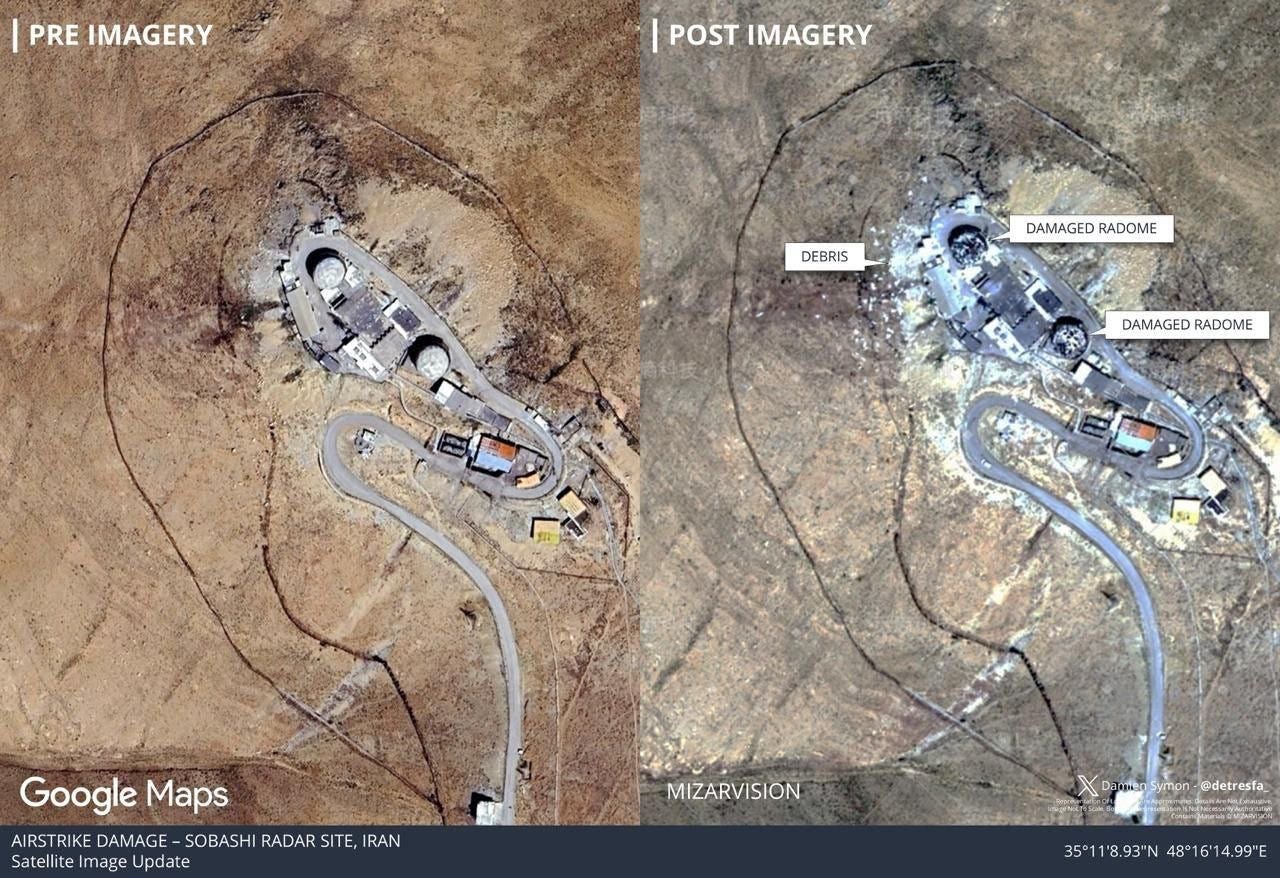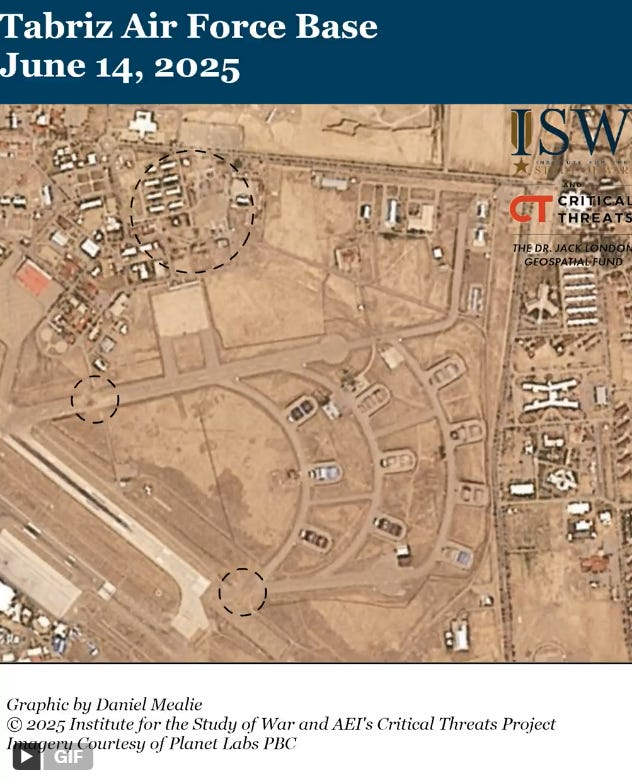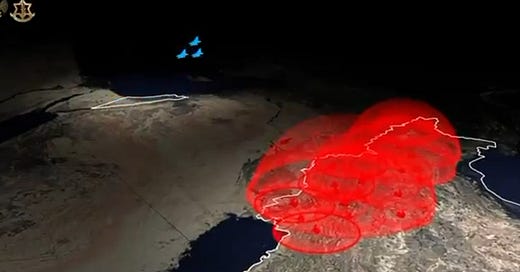Quick Turn: How Did Israel Achieve Air Superiority?
Probing the Collapse of Iran's Air Defense Network.
The initial 48 hours of Operation Rising Lion have provided a compelling look at how a modern military can neutralize a nation’s air defenses. While I don’t claim expertise in Iranian or Israeli military capabilities specifically, my background in C4ISR analysis offers a unique lens for understanding these operations. Rather than cataloging the 100+ reported targets, a C4ISR-focused approach examines the critical nodes whose destruction created cascading, system-wide effects across Iran’s air defense network.
From this architectural perspective, let’s examine Israel’s Suppression of Enemy Air Defenses (SEAD) campaign—specifically identifying which command, control, communications, and sensor nodes were targeted to achieve disproportionate operational impact (acknowledging that information remains preliminary as events continue to unfold, so bear with me. Kudos to The Institute for the Study of War and The War Zone for their great up-to-date coverage of the conflict).

Phase 1: Intelligence & Preparation
The kinetic assault was enabled by sophisticated intelligence groundwork, likely performed with both national and international support. While the U.S. has denied direct military involvement, Secretary of State Marco Rubio confirmed that Washington provided “exquisite” intelligence to Israel. This likely included data from a constellation of U.S. and NATO ISR assets that persistently monitor the region. Signals intelligence gathered by platforms like the RC-135 Rivet Joint, which were patrolling the periphery of Iranian airspace, would have provided a baseline Electronic Order of Battle (EOB), mapping the locations and frequencies of Iranian radars long before the operation began.
This was augmented by Israel’s own national technical means. Ofek-series imaging satellites would have provided high-resolution imagery of key sites, while Israeli Air Force Gulfstream G550 SIGINT or EW aircraft would have refined the EOB.
Crucially, this phase also included clandestine action. Reports claim Mossad ground teams pre-positioned weapons, including Spike NLOS guided missiles and loitering munitions, near key C4ISR facilities. This on-the-ground human intelligence (HUMINT) would have been essential for final verification of mobile or concealed targets

Phase 2: Dismantling Iran’s C2 Network
The operation’s kinetic phase likely began with a near-simultaneous, multi-domain assault on Iran’s primary C4ISR nodes, timed to the second. This a deliberate effort to induce systemic paralysis.
The Electronic & Cyber Salvo:
The first blow was likely non-kinetic. Just before the first physical impacts, reports from internet watchdog NetBlocks confirmed a massive internet disruption, with connectivity dropping by nearly 50% across the country. While officially attributed to a government-imposed shutdown, the scale of the outage suggests that a targeted Israeli cyber or electronic warfare campaign, aimed at the same dual-use telecommunications infrastructure, was a compounding factor that ensured a more chaotic and complete collapse of connectivity.
This would have been paired with a multi-layered electronic assault. Reports indicate the use of dedicated Israeli platforms, with Gulfstream G550 “Eitam” aircraft likely conducting powerful stand-off jamming from a distance, while F-16I “Sufa” fighters equipped with advanced ECM suites executed the kinetic strikes.
The Physical C2 Takedown:
With the network in chaos, physical strikes destroyed the most critical “eyes” and “brains” of the IADS.
Strategic Sensors: The confirmed destruction of the Sobashi VHF long-range radar in Hamadan created a massive, 350-400 kilometer blind spot in the western air corridor. The reported strike on the West Tehran early-warning radar was arguably even more significant, as it protected the national “center of gravity.” As of mid-June 14, the IDF claimed it had “achieved full freedom of operation in the air space” around Tehran.

Command Hubs: The decapitation strikes against senior military leaders, including Armed Forces Chief of Staff Mohammad Bagheri and IRGC chief Hossein Salami, were a direct attack on the human nodes of the C2 system. This was compounded by strikes on physical headquarters, such as the reported hit on the IRGC “Ghadir” integration site in Tehran, a facility possibly critical for the command and control of Iran’s advanced missile programs.
Communications Nodes: Complementing the non-kinetic assault were direct physical strikes on communications infrastructure. A confirmed daylight airstrike hit an Iranian communications facility in Chitgar, an area of Tehran known to host IRGC sites. Another attack reportedly targeted a communications tower in Karaj. These almost certainly were deliberate efforts to physically sever the data links connecting command posts to their subordinate units, ensuring that even if a SAM battery was still operational, it could not receive orders.
Airbase C2: Strikes on Nojeh Air Base destroyed both aircraft hangars and its tactical surveillance radar, blinding the base and preventing it from vectoring its own fighters or cueing its local SA-6 air defenses.
Phase 3: Degrading Iranian Force Generation
The successful paralysis of Iran’s C4ISR network in the opening hours directly enabled the subsequent phases of the operation. As ISW noted before the conflict, destruction of parts of Iran’s air defenses “would enable Israeli 4th-generation, non-stealthy aircraft to operate in Iranian airspace with greater ease.”
This is precisely what we have seen. With the IADS network shattered, the bulk of the Israeli Air Force—its fleet of F-15I and F-16I jets—could operate with a degree of impunity that would have been impossible against a functioning, layered defense. They were free to strike regional C2 hubs like the 2nd Tactical Airbase (TAB-2) in Tabriz, cratering its runways to keep Iranian fighters on the ground. They could systematically destroy missile storage and launch facilities at Amand, Bakhtaran, and Bid Ganeh, physically limiting Iran’s ability to retaliate

Phase 4: Attrition of Sustainment
Finally, the campaign targeted the logistical and energy backbone required to sustain a modern military. Strikes against the South Pars gas plant, the Fajr-e Jam Gas Refinery, and the Shahran oil depot in Tehran were classic Phase II interdiction strikes (assuming they’re not just cost imposition activities). Without a reliable supply of electricity and refined fuel, Iran’s air defense generators, missile production plants, and military vehicle fleets cannot operate for a sustained period. This line of effort aims to cripple Iran’s ability to reconstitute its forces in the coming days and weeks.
Israel’s Functioning Kill Web
Israel could execute this complex operation because its own C4ISR architecture is mature, integrated, and networked. Where Iran’s system is a brittle patchwork, Israel’s functions as a cohesive whole.
The Network: Israeli forces are connected by a mix of datalinks. This includes the NATO-standard Link 16 for interoperability and indigenous systems for secure, high-bandwidth communication. Critically, Israel operates its own Amos-series of communication satellites, providing the vital reach-back capability that allows a Mossad team deep inside Iran to communicate directly with the IDF’s central command bunker in Tel Aviv.
The Brain: At this central command, battle management systems like Elbit’s Torch-X family would have fused the incoming data (a satellite image of a targeted facility, a SIGINT hit from a G550, and a HUMINT report from a ground team) into a single, actionable intelligence picture.

The Kill Chain: This integrated network is what enables the accelerated kill chain. Data from a Mossad spotter can be pushed directly to an F-15I, whose crew can then use the advanced sensors on their own aircraft to verify and engage the target with a standoff weapon like a Popeye missile.
Conclusion: A Systemic Collapse
This multi-pronged, systems-level attack demonstrates a sophisticated understanding of network-centric warfare. Israel’s attacked the synapses of the Iranian C4ISR architecture. It cut the sensors (radars) to induce blindness, choked the shooters (missile launchers and airfields) to induce paralysis, disrupted the command network through leadership decapitation, and degraded the sustainment (energy) to induce exhaustion. The simultaneous assault on all four of these pillars is what produced the rapid, cascading collapse of Iran's defenses we have witnessed in the opening days of this conflict.
Aftermath and Potential for Reconstitution
With its C4ISR network probably shattered across Tehran and out west, Iran’s subsequent attempts to retaliate were significantly degraded. The destruction of missile storage and launch facilities at Amand, Bakhtaran, and Bid Ganeh physically limited the number of missiles available for a counter-strike.
Looking ahead, Iran’s ability to reconstitute its C4ISR network is extremely limited in the short term. Physically rebuilding a strategic radar site like Sobashi is a process that takes months, if not years. The slain commanders represent decades of institutional knowledge that cannot be easily replaced.
This operational reality will almost certainly force Tehran to accelerate its long-standing efforts to acquire more advanced and, crucially, more integrated air defense systems from its strategic partners, Russia and China. The demonstrated failure of its current systems makes this a strategic necessity. While delivering such a system during active hostilities would be challenging, my guess is that it’s not impossible. Heavy equipment like an S-400 could be transported via the Caspian Sea from Russia’s port at Astrakhan to Iran’s port of Anzali, a route largely outside the effective range of Israeli airpower.
However, the hardware is only part of the solution. The true challenge lies in integration. The logistical timeline for shipping, deploying, and training crews on a complex new system like the S-400 would take many months, offering no immediate relief. Furthermore, integrating it into a new, coherent C2 network would require extensive software engineering and technical support, likely necessitating the presence of Russian or Chinese advisors on the ground. This conflict has provided a brutal lesson for Tehran: possessing individual “silver bullet” platforms is meaningless without the robust, resilient, and integrated C4ISR network needed to connect them.





I am thinking about writing an article on Israel‘s objectives in its operation in Iran and how the IDF attempts to achieve it through the disruption of destruction of critical infrastructures. If I find the time, I will take your findings into account.
The psychological terror for an Iranian captain, lieutenant or tech sergeant calling HQ ☎️ and getting 'no signal' is the kind of thing that gets missiles fired into passenger airlines (1/8/2020) by desperate 🔕⚡and cut-off isolated units.🪦 The multi-faceted 💎⚠️ 🔃 operation you have described 🫢✍🏼🤔 reveals the human fear and helpless between the lines.... Lord, have mercy.